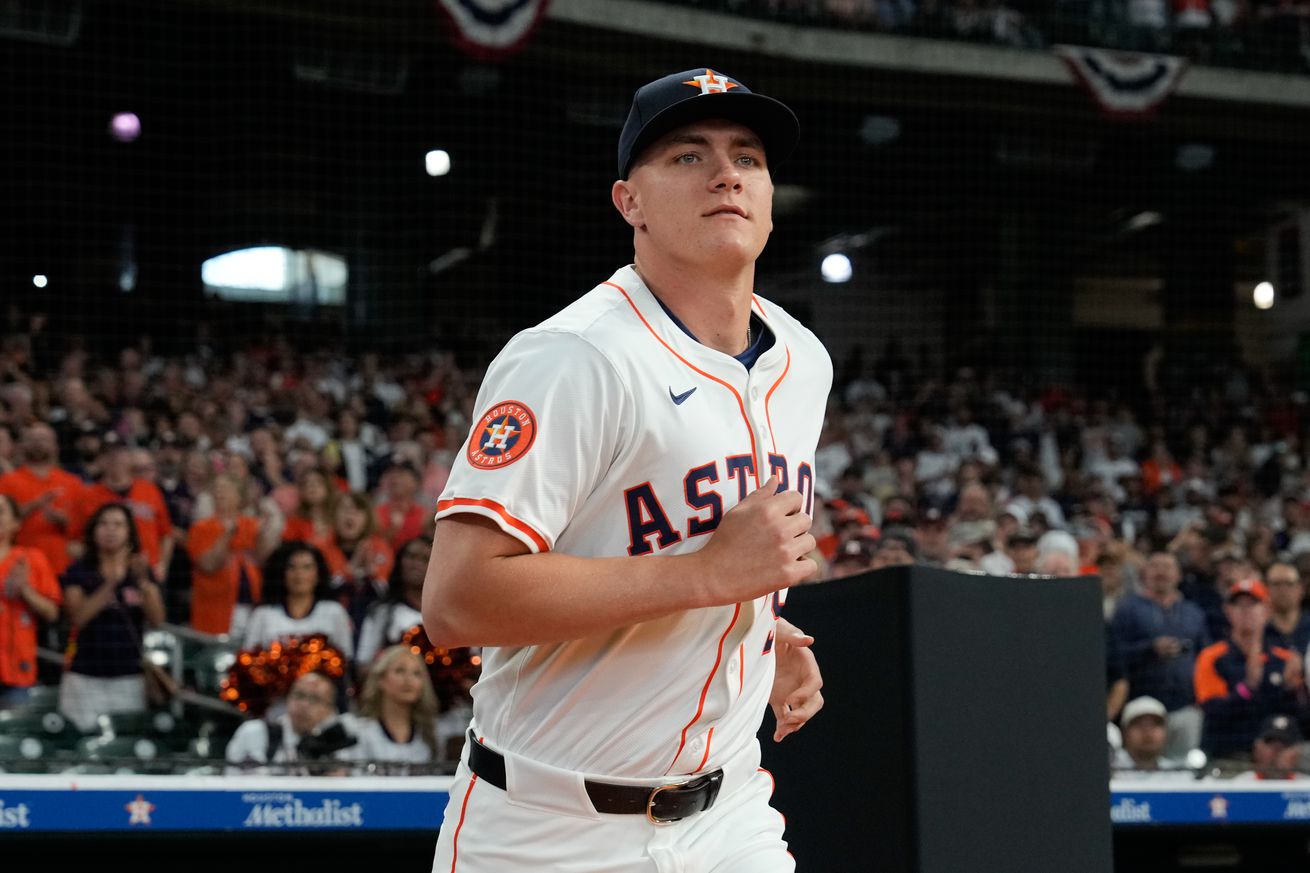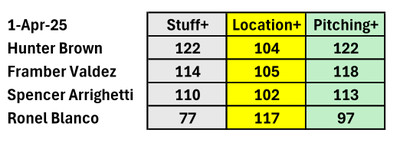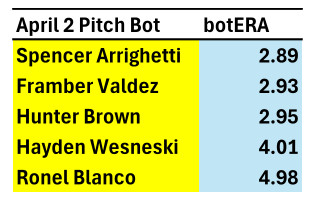
It’s very early, but a few thoughts over the first five days of 2025 season….pertaining to both Astros’ starting pitchers and opposing starting pitchers
All five starting pitchers in the Astros’ rotation have a game in the books for 2025. Now that we have one complete turn through the pitching rotation, we can look back and evaluate how well they performed.
Of course, 1 game for each pitcher is just that, one game. If you want to draw inferences about how well they will perform in the future, well you can’t. This is just a small sample in 2025. But we can evaluate how well they started the season.
With sample sizes ranging from 5 -7 IP, pitching stats like FIP, ERA, or K/9 do not tell us much. However, a pitch modeling measure like Stuff+ might give us some information about the underlying quality of the pitches.
Stuff+ is based on the physical attributes of each type of pitch, such as velocity and movement. Location+ is a component of Stuff+ pertaining to how well the pitches are located. Pitching+ is a composite of Stuff+ and Location+. 100 is “average” for these metrics.
The Stuff+ metrics for the first game of 2025 pitched by Framber Valdez, Hunter Brown, Spencer Arrighetti, and Ronel Blanco are shown below.

Fangraphs
As you can see, Brown had outstanding stuff in Friday’s start and leads the team in Stuff+ and Pitching+. Brown averaged 98 mph on his FB in that game—higher than his 96 mph average in previous years. Both Framber Valdez and Spencer Arrighetti also scored well on Pitching+ and Stuff+. All three are well above “average.” Ronel Blanco, on the other hand, was well below average in terms of Stuff+ and Pitching+. However, Blanco compensated somewhat by locating his pitches better, and was well above average on Location+. Blanco will go as far as his command takes him. Since Stuff+ doesn’t address pitch sequencing, better sequencing is also a pitching tactic he can use to compensate for stuff deficiencies.
The Stuff+ results for Hayden Wesneski’s start on Tuesday were unavailable when I first started writing this, but the numbers were computed this morning as follows:
Wesneski Stuff+ 96 Location+102 Pitching+ 99
Wesnsski’s stuff was better than Blanco’s, but his command wasn’t as good as Blanco, leading to a composite Pitching+ number close to average.
PitchBot is an alternate pitching model utilized on fangraphs. The model is similar to Stuff+ because it evaluates the physical characteristics of pitches. PitchBot computes estimated run values for the pitches and provides its own version of expected ERA based purely on stuff.

Fangraphs
According to PitchBot ERA, Arrighetti leads the Astros’ rotation so far in botERA. In fact, Arrighetti, Valdez, and Brown are closely spaced with botERA’s below 3. So, this model also liked the stuff shown by those three pitchers in the first turn through the rotation. Blanco’s 4.98 botERA is not very good, but it is similar to the Stuff+ view of his stuff. Wesneski falls between the Top 3 and Blanco with a 4.01 botERA. The 4.01 botERA for last night’s performance is acceptable for a No. 5 starter and lies in the range of Wesneski’s ERA projections for 2025.
Some further observations based on the initial Stuff+ results by pitch type:
- Hunter Brown’s Stuff+ was good across the board for all his pitches, with the highest stuff rating given to his 4 seam FB (135). Valdez pitched with above average stuff for all his pitches, with the breaking pitches (Slider, Curve, Change) showing the highest stuff rating.
- Arrighetti had very good stuff on his fastball, curve, and slider. However, his cutter and change up were below average pitches.
- Wesneski’s slider is well above average and his fastball is average, according to Stuff+. But the remaining three pitches were below average. Blanco did not have a good stuff rating on any of his offerings.
While Stuff+ and PitchBot provide some insights about the pitchers’ underlying pitch performance, it’s only one game, which is too small a sample to extrapolate into future performance. But if you want a take away from a small sample: the 1 -3 spots in the rotation are shaping up well, with potential for excellent pitching. The No.4 and 5 spots may be a bit more problematic, but we may see improvement in stuff from those positions in the rotation. It will be interesting to see when Lance McCullough Jr. returns and how the rotation might be adjusted to include him.
A Thought on Opposing Rotations So Far
Understandably people are focused on the underwhelming batting performance by the Astros so far. But what about the starting pitchers faced by the Astros so far? With the trade of Kyle Tucker, the Astros’ batting order currently is extremely righthanded. In previous articles, I suggested that opposing teams would attempt to take advantage of this characteristic by arranging their rotations to put tough RH pitching up against the Astros and possibly minimizing the use of LH relief pitchers.
How is that working out? There are some early data points to surmise that opponents are doing exactly that. The Astros have fewest plate appearances (9) against LHP of any team so far this season. The league median is 48 plate appearances against LHP, which is more than 5 times as many LHP PA.
Moreover, the Astros have faced RH starting pitchers who are very tough on right hand bats. Surely this provides some context for the Astros’ cold offensive start to the season.
Here is the career BA against RHB by the starters so far:
Holmes .211
Megill .237
Canning .266
Hicks .200
Webb .245
With the exception of Canning, all of the opposing starters so far have strong splits against RHBs. Today’s starter (Roupp) doesn’t have such strong splits against RHB (.255), so hopefully the Astros’ offense can take advantage.
Another important factor is that the Astros’ lone LHB, Yordan Alvarez, has started out the season looking out of synch at the plate. Surely he will regain his timing at some point and provide better platoon balance to the lineup.
The way that opposing teams address the Astros’ lack of platoon balance is a trend to follow going forward.